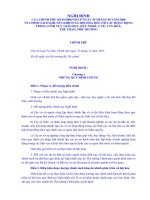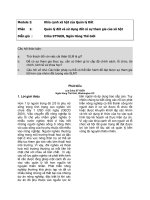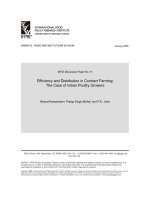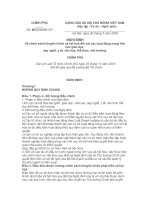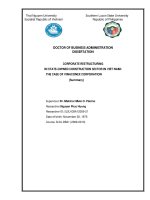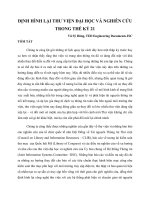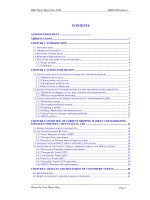Sales force management in undergraduate education the case of FPT University = Quản lý đội ngũ bán hàng trong lĩnh vực giáo dục đại học và nghiên cứu trường hợp của Trường Đại học FPT
Bạn đang xem bản rút gọn của tài liệu. Xem và tải ngay bản đầy đủ của tài liệu tại đây (1.27 MB, 76 trang )
VIETNAM NATIONAL UNIVERSITY, HANOI
SCHOOL OF BUSINESS
TA THI MAI LOAN
SALES FORCE MANAGEMENT IN UNDERGRADUATE EDUCAITON
THE CASE OF FPT UNIVERSITY
Major: Business Administration
Code: 60 34 05
MASTER OF BUSINESS ADMINISTRATION THESIS SUMMARY
Supervisor: Dr. Tran Doan Kim
Hanoi – 2012
vi
TABLE OF CONTENTS
ACKNOWLEGEMENT i
ABSTRACT ii
TÓM TẮT iv
TABLE OF CONTENTS vi
LIST OF TABLES viii
LIST OF FIGURES, CHART ix
INTRODUCTION 1
1. Problem background 1
2. Objectives and aims 2
3. Research Question 2
4. Scope of work 2
5. Data collection 3
6. Methods 3
7. Significance 3
8. Limitation 3
9. Expected results 4
CHAPTER 1: LITERATURE REVIEW 5
1.1 Definition and Importance of Sales force management 5
1.2 Formulation of a strategic sales program 7
1.2.1 Set goals and objectives 7
1.2.2 Forecast sales 7
1.2.3 Determine sales force size and structures 9
1.2.4 Design sales territories 11
1.2.5 Set sales quotas 13
1.3 Implementation of the Sales program 14
vii
1.3.1 Recruiting sales personnel 14
1.3.2 Selecting sales personnel 16
1.3.3 Training the sales force 18
1.3.4 Motivating sales personnel 22
1.3.5 Compensating sales personnel 24
1.3.6 Sales meetings and sales contests 25
1.4 Special considerations of sales force management in education sector 25
CHAPTER 2: ANALYSIS OF FPT UNIVERSITY SALES FORCE 27
2.1 Introduction about FPT University 27
2.1.1 History of FPT University 27
2.1.2 Organization structure 28
2.2 Sales forces management at FPT University 29
2.2.1 Model 29
2.2.2 Implementation of sales force management at FPT University 31
2.2.3 Measuring sales force productivity 36
2.2.4 Customer satisfactions 40
2.2.5 Some overview on Education market and Sales force management
in some other Universities and Institutions 42
2.2.6 SWOT analysis 44
CHAPTER 3: RECOMMENDATIONS 48
3.1 Restructuring sales department 48
3.2 Building Compensation and Promotion policies 50
3.3 Improving recruitment and training 54
3.4 Applying CRM software 64
3.4.1 What is CRM? 64
3.4.2 Why should FU apply CRM in sales activities? 65
3.5 Improving customer satisfactions 65
REFERENCES 68
viii
LIST OF TABLES
Table 2.1: Staff’s satisfaction 35
Table 2.2: Sales Volumes at FPT University 37
Table 2.3: Percentages of remain students 39
ix
LIST OF FIGURES, CHART
Figure 1.1: The Forecasting Process 8
Figure 1.2: Question To Answer To Improve Chances Of 9
Figure 1.3: Line Sales Organization 10
Figure 1.4: Line and Staff Sales Organization 10
Figure 1.5: Functional Sales Organization 11
Figure 1.6: Factors to consider when designing territories 13
Figure 1.7: A selection System 16
Figure 1.8: A Sales Training Model 18
Figure 1.9: Maslow's hierarchy of needs 24
Figure 2.1: FPT University structure 30
Figure 2.2: Sales department structure 31
Chart 2.1: Number of Training Cource 33
Chart 2.2: Bonus rate 34
Chart 2.3: Staff’s Satisfaction of Promotion 35
Chart 2.4: Work Love 35
Chart 2.5: Quit Reasons 36
Chart 2.6: Sales Volumes at FPT University 38
Chart 2.7: Percentages of Remain Students 40
Figure 3.1: Sales Structure Recommended 50
Figure 3.2: Recruitment Process 59
Figure 3.3: New Staff training Process 60
Chart: 3.1: Staff’s Training Course Required 63
1
INTRODUCTION
1. Problem background
Sales force is a powerful asset of selling organizations. It is a crucial factor
contributes to the success and stable development of the firm. A good sales
force management can help the company to increase productivities as well as
its competitive advantages. In the past, Vietnamese always think traditionally
that there is not the relationship between the buyers and sellers in the
education in Vietnam. They believe that education belongs to the government
and they think that the relationship between students and professors, between
purples and teachers are some things respectful which cannot be bought and
sold. In some recent years, with the open door policy of the Ministry of
Education, there have been many Schools and Universities both State owned
and private being born. There are more than 200 all kinds of Universities in
Vietnam up to now. With the population of more than 80 million, the demand
of training, which cannot be satisfied by the state owned University system, is
very high. The appearance of the private high standard Universities like FPT
University, Dai Nam University, Van Xuan University, Chu Van An
University… is more and more, especially the corporate training programs in
Vietnam like Troy, Latrobe, Grigg, RMIT, North Central… In which FPT
University is one of the model of University of company in Vietnam. To
compete and survive, FPT University has considered the university like an
invisible product to sales and organized its sales force. At the first time, the
university had a certain success because of the high appreciation on sales as
well as the way it sales in undergraduate education. However, after some
years of operation, the competitors has quickly copied the way it sales and it
seems that the university has some difficulties now.
2
The thesis “Sales force management in undergraduate educaiton the case of fpt
university” is aimed to study and propose solutions to improve sales force
management at FPT University as well as it can be applied in other
undergraduate institutions in Vietnam.
2. Objectives and aims
In order to study an overview of sales force management in education in
Hanoi and analyze the case of FPT University, the study aims to achieve the
following objectives:
Summarizing basic theory about sales force management
Showing an overview of sales force management in education sector
Analyzing FPT university activities in sales force management
Giving the conclusions and recommendations to improve the sales
force management at FU
3. Research Question
To fulfill the objectives of the study, the following research questions need to
be answered:
How is the sales force management in undergraduate institutions?
What FU has done so far?
What FU can do to improve the sales force management?
4. Scope of work
The thesis studies on sales force management in undergraduatie education in
Hanoi, focusing on private universities and corporate programs which have
high tuition fee and need so much effort to sales. Base on the study on the
overview of sales management in undergraduatie education in general the
thesis also point out some recommendations for FU sales force management.
3
5. Data collection
The data is collected from textbook of sales force management, human
resource management and some websites related to this topic. It is also
collected from the experiences when I worked for sales department of FU for
two months.
6. Methods
This study applies the two following methods:
Reviewing of related literature
Interviewing relevant people
Reviewing of related literature: This will examine the multidisciplinary
theories of sales force management and compare between theory and practical
activities.
Interviewing: Questions will be developed and structured interviews are
conducted for those who are professors in this field and who are people in
charge of FU’s sales force.
7. Significance
In the perspective of increasingly high competition and sales pressure, the
study focuses on analyzing and recommending useful solutions to enhance the
effectiveness of sales force management and competitiveness of FU. Besides,
this study also gives the overview of the sales force management in
education- the conception has been recognized but not yet mentioned directly.
8. Limitation
The limitations of the study lay on analyzing only FU. Date sources are not
rich enough to have a bigger picture of this industry. Moreover, most
information collected from inner operation therefore it has been hard to
4
approach and collect. As a new field that not yet mentioned before, it is also
hard for the author to get references from other researches and sources.
9. Expected results
The study will give a general overview of sales force management in
Vietnam’s education industry, which is an old but new conception.
By the observation, analysis and report on the current situation of FU, the
author hopes that her solutions given in this study will be applied in reality
and will bring some certain effectiveness for FU sales force.
5
CHAPTER 1: LITERATURE REVIEW
1.1 Definition and Importance of Sales force management
Sales force serves as a critical link between a company and its customers. The
salesperson can represent both buyer and seller. They represent company to
the customer and customers to the company. Salespeople are becoming more
market-focused and customer-oriented. The old view was that salespeople
should be concerned with sales and the company should be concerned with
profit. The new view is that salespeople should be concerned with more than
just producing sales- they must know how to achieve customer satisfaction
and company profit.
- Definition by Wikipedia, it is defined as follow: “Sales management
is a business discipline which is focused on the practical application of
sales techniques and the management of a firm's sales operations. It is
an important business function as net sales through the sales of
products and services and resulting profit drive most commercial
business. These are also typical the goals and performance indicators of
sales management”
- Definition by the American Marketing Association [1] “The
planning, direction, and control of the personal selling activities of a
business unit, including recruiting, selecting, training, equipping,
assigning, routing, supervising, paying, and motivating as these tasks
apply to the sales force.”
- Definition by Richard R. Still; Edward W. Cundiff and Norman
A.P. Govoni [2] :“Sales management originally referred exclusively to
the direction of sales force personnel. Later, the term took on broader
significance – in addition to the management of personal selling, sales
management meant management of all marketing activities, including
6
advertising, sales promotion, marketing research, physical distribution,
pricing, and product merchandising.”
- Definition by Charles M. Futrell [3] “Sales management is the
attainment of sales force goals in an effective and efficient manner
through planning, staffing, training, leading, and controlling
organizational resources”
In general, sales force management which is referred to personnel-related
responsibilities, involves a number of key areas including: performance
measurement, selection and training of sales people and motivational
methods.
Sales force management involves three different tasks. Firstly, it is the
methods for selling and managing a sales territory. There are no prescriptive
methods for doing this and is anything, an adaptive approach to selling is
probably best. Secondly, it is the supervision by management which should
include valid performance measurement and suitable motivation methods.
The third task is concerned with the setting up of a sales force in terms of its
organization. The organization and structure of the sales force depend on
several factors. Different business scenarios require different types of sales
force organization. It may be possible to increase sales productivity by
attempting new methods of sales allocation. The new models of sales
allocation are: Segment-based sales force, Functional sales force, Consultative
sales force, Enterprise sales force, Transactional sales force, Hybrid/Queuing
sales force. A highly motivated sales force is instrumental in increasing the
sales productivity of the organization.
7
1.2 Formulation of a strategic sales program
1.2.1 Set goals and objectives
Goal setting methods are rooted in approaches for identifying market potential
and other key drivers that impact performance. Goals are based upon three
key factors: Marketing’s view of customer potential, the sales organization’s
view of what is possible and management’s insights and expectations. Sales
force management creates a top-down, bottom-up analytical approach and
develop goals that link to the company’s expectations as well as gain the buy-
in of all key stakeholders. A typical goal setting will consist of an in-depth
analysis of customer base, followed by a rigorous analytical development of
potential estimation.
1.2.2 Forecast sales
In sales management, sales forecast is very important because inaccurate
demand estimation can be costly. The firms not only need to identify market
opportunities but they also need to produce accurate estimates of demand for
products, the result from this activity.
Market opportunity analysis involves:
8
Estimation of market potential or the expected sales of commodity by
the entire industry serving the market during stated period.
Estimation of sales potential or the share likely to be realized by the
company
Preparation of the sales forecast or the estimate of sales for a specified
future period under an assumed marketing plan.
Figure 1.1: The Forecasting Process
There are several methods for sales forecasting as follows:
Users’ expectations: This method is also known as the buyers’
intentions methods because it relies on the answers of customers about
their expected consumption or purchases of the products.
Sales force composite: This method requires every sales people to
estimate their expected sales. These estimations are discussed revised,
and then pooled to other levels of the sales organization hierarchy.
Jury of executive opinion: this method is also called expert opinion
method. It pools the top executives of the company to assess the sales
possibilities for the next period. The forecast may be done by average
the individual judgment or by group discussion. Besides, Delphi
Forecast Objective
Determine dependent and
independent Variables
Develop forecast
procedure
Select Forecast
Analysis Method
Total Forecast
Procedure
Gather and
Analize Data
Present Assumptions
about Data
Evaluate Results
versus Forecast
Make and Finalize
Forecast
9
technique is also used in this procedures each one in the group submits
a forecast to the group coordinator. The estimation summary is
prepared by coordinators and distributed to the ones who submit
forecasts. Then their estimates are revised by them if necessary. The
process continues until a reasonable consensus is reached.
The market test: It is a controlled experiment where product is placed
in several representatives cities to see how it performs and then the
result are projected to the area in which the firm operates.
Time series analysis: The analysis of historical data is used to develop
sales forecast.
Statistical demand analysis: Relationship between sales and the
important factors affecting sales is determined to forecast the future.
Depend on the business field of the firm, sales manager will choose the most
suitable methods to apply. Don’t Just Do One Sales Forecast!
Figure 1.2: Question To Answer To Improve Chances Of
Hitting The Forecasting Bull’s Eyes
1.2.3 Determine sales force size and structures
Organizing the sales force makes the company to achieve the sales objectives
in a more effective way. It helps to realize sales targets smoothly and ensures
10
sales productivity for long time. A sales force should be built in specialized
groups and make the sales increasing stably and continuously. There are many
factors influence to the sales force’s organization and structure. Different
business scenarios require different types of sales force organization.
Basic types of sales organizational structures consist of: (1) Line; (2) Line
staff; (3) Functional; (4) Geographic; (5) Product; (6) Market
Figure 1.3: Line Sales Organization
Figure 1.4: Line and Staff Sales Organization
General Manager
Sales manager
Assistant sales
manager Division 1
Assistant sales
manager Division 2
Assistant sales
manager Division 3
Sales people
Sales people
Sales people
11
Figure 1.5: Functional Sales Organization
Besides the sales organization, the decision on sales force size is also a key on
personal selling strategy. The sales manager needs to determine how many are
required to meet the sales volume. There are three basic methods are used:
(1) The work load method
(2) The sales potential method
(3) The incremental
The work load method the basic assumption is that all sales personnel should
shoulder equal work loads. Management first estimate the total work load
involved in covering the company’s entire market and then divide for
individual sales personnel handle. Companies applying this approach
generally assume that the interactions of three major factors : customers size,
sales volume potential, and travel load – determine the total work load
involved in covering the entire market [4]
1.2.4 Design sales territories
A sales territory is a group of potential customers assigned to salesperson to
contact and sales products. The customers and geographic boundaries are the
12
key to design sales territory but the key is distinguishing component is
customers. Good sales territories are made up of customers who have money
and willing to spend it. Good sales territories design can positively influence
individual’s interest and morale, it also can improve market coverage and
evaluation and control selling field of the firms.
Sales force is a productive asset of the firm what brings most profit but it is
also costly. Increasing salespeople will increase sales volume and cost
relatively. It is necessary to decide sales force size before design territories for
sales people. There are three popular methods for determining the size of
sales force:
Breakdown method: this method relies on estimation of sales volume
per one salesperson and sales forecast to determine sales force size.
Number of Salespeople = Sales forecast/Estimation of sales volume
per salesperson
Workload method: this method rests in assumption that all sales
personnel should responsible for an equal work amount. Management
estimates total work required to serve the market; calculates the number
of customers, total time to contact them and the time available for one
salesperson. Base in this forecast, manager determine total number of
sales force.
Incremental method: This is the most difficult method to implement
because this method bases on basic premise underlying the incremental
method. It means that sales representatives should be added so long as
the incremental profit produced by their addition exceeds the
incremental cost.
Once the number of the territories is determined, the sales manager can design
the individual territories. The general process might be expected to follows:
13
Figure 1.6: Factors to consider when designing territories
1.2.5 Set sales quotas
A sales quota is the sales goal assigned to a marketing unit in a specified
period. Sales quotas may be high or low depend on customer, product and
market situation. The quota plan is a full set of quota assignments.
Sales quotas are used to motivate salespeople, evaluate their performance and
control their efforts. For a quota plan to produce its potential benefits, the
quotas must be attainable with normal effort, easy to understand and
complete.
Quotas setting process includes:
Select types of quotas: This choice entails determining whether the firm
will use quotas that emphasize:
Sales or some aspect of sales volume
The activities in which salespeople are supposed to engage
Financial criteria such as gross margin or contribution to overhead
Determine relative importance of each type: Most firms seek some
mechanism for combining the individual quotas in to a single summary
measure that serves as the standard for each representative’s
performance. Often a linear combination or weighted average is used in
Select Basic Control
Unit
Customer Contact
Plan
Assign to
Territories
Analyze Workload
Determine Basic
Territories
Evaluate, Revise if
needed
14
which the weight reflect the importance of each component to
management.
Determine the level of each type of quota: in this step, the sales
manager need to determine the level at which each type of quota is to
be set. In establishing level, sales manager must balance a number of
factors, including the potential available in the territory, the impact of
the quota level on the salesperson’s motivation, the long term
objectives of the company and the impact on short-term profitability.
1.3 Implementation of the Sales program
1.3.1 Recruiting sales personnel
Fielding the sales personnel needed to service the company’s customers and
prospects is a key responsibility of sales executives. Discharging this
responsibility requires that the sales executive implement personal-selling
strategy in terms of both the kind and number of sales personnel.
Implementation is by no means a simple process. Having determined the
desired kind of sales personnel, implementation requires job analysis, the
writing of job descriptions, and the deriving of job specifications so that
recruiters will know the qualifications they should look for in prospective
sales employees and sales trainers will know what additional qualifications
they should aim to provide newly recruited sales personnel.
Recruiting and selecting sales personnel is an important part of implementing
personal-selling strategy, but it is not all that involved. Initial sales training is
required to bring new sales personnel up to expected productivity levels, and
continuing sales training is needed to maintain more experienced sales
personnel at high levels of productivity. Motivation and supervisory efforts
help in stimulating sales personnel to apply their skills effectively. It is one
15
thing for sales personnel to know what they are supposed to know, but it is a
different thing to get them to apply what they know.
In general, there are three main steps in recruiting and selecting a sales force.
Step 1 is to evaluate the sources from which sales personnel with good
potentials are obtainable. Step 2 is to tap the identified recruiting sources and
build a supply of prospective sales personnel. Step 3 is to select those who
have the highest probability of success.
The organization for recruiting and selection of sales personnel varies from
company to company. Company size, executives’ personalities, and the
departmental structure all influence the organization used. Where the sales
manager has a personnel staff assistant, recruiting and selection usually is
handled entirely within the sales department.
Sources of sales force recruits includes:
Sources within the company
Company sales personnel
Company executives
Internal transfers
Sources outside the company
Direct unsolicited applicants
Employment agencies
Salespeople making calls on the company
Employees of customers
Sales executives’ clubs
Sales forces of noncompeting companies
Educational institutions
16
1.3.2 Selecting sales personnel
Selection systems for the sales personnel range from simple one-step systems,
consisting of nothing more than an informal personal interview, to complex
multiple-step systems incorporating diverse mechanisms designed to gather
information about applicants for sales jobs. A selection system is a set of
successive “screens”, at any of which an applicant may be dropped from
further consideration.
Figure 1.7: A selection System
Pre-interview screening and preliminary interview
This step is in order to eliminate obviously unqualified applicants. The
preliminary interview can be handled by a low paid clerk or secretary.
Formal applicant form
Formal applicant form is used for collecting the information after a
preliminary interview which indicates that the job candidate is promisingly a
company salesperson. It is filled out by the applicant personally or by an
interviewer who records the applicant’s response.
Interview
17
Interview is most widely used selection step and in some companies it
comprises the entire selection system. No other method is quite so useful for
evaluating candidate’s abilities in oral communication, personal appearance,
attitude toward selling and life in general, reaction to obstacles presented face
to face, and personal impact on others.
The recruiter involves in one interview should probably be several persons to
interview and evaluate each applicant. Usually in large company, branch sales
managers or their assistants and human resource executive handle the initial
formal interview and then home office involves in subsequent ones.
There are several interview techniques such as: patterned interview (using a
prepared outline of questions designed before the interview); nondirective
interview (the candidates have chance to talk freely about his or her
experience, training, and further plans and no fixed or standard answers will
be given); interaction interview (providing cases which show stresses the
applicant would meet in actual selling and see how his or her reactions to
them); and rating scales (the interviewer rate the candidate via many criteria
such as appearance, experience or ability and so on, then make the selection).
Reference and credit check
References provide information on the applicant not available from other
sources. The excellent references should be considered are: present or former
employer, former customers, reputable citizens and mutual acquaintances.
Testing
Test is also a useful way that many companies used to select the best
candidate. For sales person position, some tests is related to psychological
such as tests of ability, of habitual characteristics and of achievement.
Physical examination
18
As good health is crucial to a salesperson’s success, most companies require
physical examination. It is usually the last step because of the relatively high
cost.
In short, an appropriate selection procedure and its skillful execution result in
greatest selling efficiency. Good selection puts the right persons to the right
job and in the right time, therefore increasing job satisfaction and reducing the
cost of personnel turnover.
1.3.3 Training the sales force
Sales training program is necessary in each sales department. This helps to
improve the job performance. In the absence of training, job performance
improves with experiences but it takes time. In most companies, the rate of
sales personnel turnover is higher for new personnel than for experienced
people – often new sales personnel find themselves unprepared to perform
their jobs satisfactorily, become discouraged, and leave the company. If sales
training help new sales personnel to perform their jobs satisfactorily, the rate
of sales personnel turnover declines, recruitment and selection cost falls, and
overall efficiency of the personal-selling operation climbs.
Figure 1.8: A Sales Training Model
Building Sales training programs
There are several types of sales training programs. The most comprehensive
and longest is the training program for newly recruited sales personnel. More
intensive and shorter programs on specialized topics as well as periodic
refresher courses (collectively known as continuing sales training), are
Planning
Phase
Organizing
Phase
Evaluation
Phase
Staffing
Phase
Directing
Phase
19
presented for experienced sales personnel. In addition, many companies offer
sales training programs for the sales personnel of their distributor/ or dealers.
Some programs are designed to develop individuals as sales trainers or as
junior-level sales executives. Each type of program serves a different purpose,
and its content reflects that purpose.
Building a sales training program requires 5 major decisions. The specific
training aims must be defined, content decided, training methods selected,
arrangements made for execution, and procedures set up to evaluate the
results [5].
Defining Training aims
In order to get a successful sales training program, defining the aims of the
course is the first step. If this step stops as general aims, it is not enough and
sufficient. For example, we may want to increase the sales force’s
productivity through training. We must identify what must be done to achieve
increased productivity. General aims should be translated into specific aims
phrased in operational terms.
Specific aim definition begins with a review of general aims and the means
currently employed to attain them. The process cannot be completed until
sales management perceives the training needs from which specific training
aims derive directly. Training needs, then, must be defined.
Identifying initial training needs
- Job specifications: The qualifications needed to perform the job are
detailed in the job specifications. Few people possess all these qualifications
at the time of hiring. The set of job specification needs scrutinizing for clues
to the points on which the new personnel are most likely to need training.
Other questions related to job performance need considering: How should
salespeople apportion their time? Which duties require the greatest proportion
of time? Which are neglected? Why? Which selling approaches are most
20
effective? Answers to these and similar questions help in identifying specific
training needs of newly recruited sales personnel.
- Trainee’s background and experience: Each individual enters an initial
sales training program with a unique educational background and experience
record. The gap between the qualification in the job specifications and those a
trainee already has represents the nature and amount of needed training. But it
is not practical to adjust training precisely to individual differences.
- Sales-related marketing policies
To determine initial sales training needs, sales-related marketing policies must
be analyzed. Differences in products and markets mean differences in selling
practices and policies, which in turn, point to needed differences in training
programs.
Identifying continuing training needs
Determining the specific aims for a continuing sales training program requires
identification of specific training needs of experienced sales personnel. Basic
changes in products and markets give rise to need for training, as do changes
in company sales-related marketing policies, procedures, and organization.
But even those products and markets change little and company policies,
procedures and organizations remain stable, sales personnel change, in some
aspect for the worse (as they develop, for example, careless or sloppy working
habits)
Deciding training content
The content of a sales training program, whether an initial or continuing
program, derives from the specific aims that management, after analyzing its
training needs, formulates. Initial training programs are broader in scope and
coverage than are continuing programs. Initial programs provide instruction
covering all important aspects of performance of the sales-person’s job;
